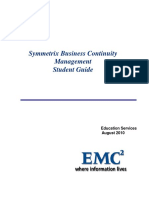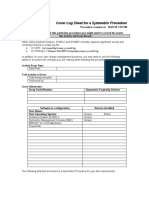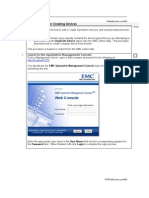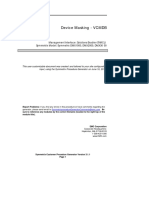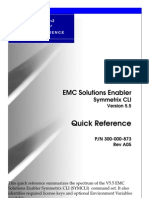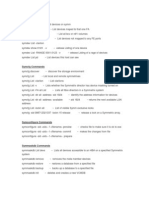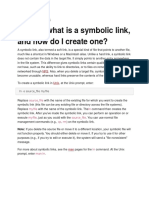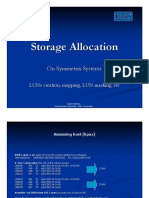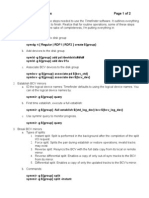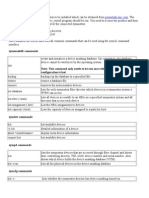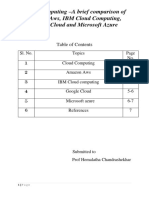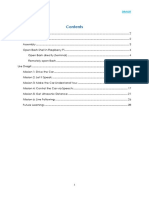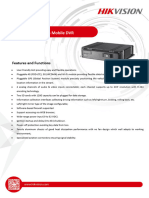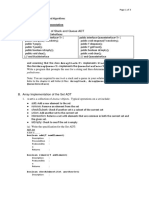Cover Log Sheet for a Symmetrix Procedure
Procedure created on: 10/29/10 7:54 PM
Before you continue with this particular procedure you might want to record the event:
Site Activity and Event Record:
When using Solutions Enabler, SYMCLI and SYMAPI normally captures significant events and
command actions to a daily log file.
On UNIX: /var/symapi/log/symapi-yyymmdd.log
On Windows: C:\Program Files\EMC\Symapi\log\symapi-yyyymmdd.log
In addition, for your own change management practices, you may want to use the following
tables to document the changes you are making while following this procedure:
Activity Event Time:
Date/Time:
Task Activity or Event:
Task being executed:
Performed by:
Array Information:
Array Serial Number Symmetrix Enginuity Version
Software in configuration Version Installed
Host Name:
Host Operating System: Version |Patch
Solutions Enabler (SYMCLI) Version
Symmetrix Management Console (SMC) Version
EMCSCF for z/OS Mainframe
PowerPath
The following attached document is a Symmetrix Procedure for your site requirements.
�� Managing TimeFinder/Clone:
Cloning a Copy of a STD to Other STDs
Management Interface: Solutions Enabler SYMCLI
Operating System: Windows 2000
This user customizable document was created and tailored to your site configuration
input, using the Symmetrix Procedure Generator on December 8, 2021.
Report Problems: If you find any errors in this procedure or have comments regarding the
generator, please send email to SymmetrixprocedureGeneratorComments@emc.com. Be
sure to reference any modules by the correct filename (located to the right-top of the
module title).
EMC Corporation
Corporate Headquarters:
Hopkinton, MA 01748-9103
1-508-435-1000
www.EMC.com
Symmetrix Customer Procedure Generator Version 3.1.1
Page 3
� INFORMATION ABOUT THIS PROCEDURE:
The Symmetrix® Procedure Generator you just ran allows you to create this customized
document specifically tailored for your site needs. It steps you through the completion of a
specific Symmetrix array management activity or host setup task that can be completed without
the involvement of Remote Technical Support. Host implementation cost is not covered under
Warranty or Maintenance. All of the generated procedures assume that you check the Symmetrix
Procedure Generator release notes to insure your selected storage management software
(SYMCLI, SMC, or EMCSCF) is up-to-date and is installed on your host as the prime storage
management tool. Since the procedure content base on Powerlink is continually being updated
and refined, it is recommended to rerun the procedure generator for your selected procedure
every 30 days to ensure currency and release control of your printed copy. If you have any
concerns, questions, or need assistance with an implementation, regarding your environment or
this procedure, contact your local sales representative.
As part of the effort to continuously improve and enhance the performance and capabilities of the
Symmetrix product line, EMC periodically releases new versions of its hardware and software, or
qualifies various operating systems interoperability with Symmetrix functionality. Therefore, some
functions described in this procedure may not be supported by all revisions of the software or
hardware you have currently in use, including your host operating system. For the most up-to-
date information on specific requirements, concerning your host environment status and storage
system, refer to the E-Lab Interoperability Navigator on Powerlink.
Copyright © 2007, 2008, 2009 EMC Corporation. All rights reserved.
Published December 8, 2021
EMC believes the information in this publication is accurate as of its publication date. The
information is subject to change without notice.
THE INFORMATION IN THIS PUBLICATION IS PROVIDED "AS IS." EMC CORPORATION
MAKES NO REPRESENTATIONS OR WARRANTIES OF ANY KIND WITH RESPECT TO
THE INFORMATION IN THIS PUBLICATION, AND SPECIFICALLY DISCLAIMS IMPLIED
WARRANTIES OF MERCHANTABILITY OR FITNESS FOR A PARTICULAR PURPOSE.
Use, copying, and distribution of any EMC software described in this publication requires an
applicable software license.
For the most up-to-date listing of EMC product names, see EMC Corporation Trademarks on
EMC.com.
All other trademarks used herein are the property of their respective owners.
Symmetrix Customer Procedure Generator Version 3.1.1
Page 4
� TABLE OF CONTENTS:
To link immediately to a specific page within this procedure, position the cursor over the page
number on the right and click.
Denotes a checkpoint
TimeFinder/Clone Standard to Standard devices 5
TFCloneStdtoStds_sym001
TimeFinder/Clone Standard to Standard devices
Overview Done
In the following TimeFinder/Clone example, the data from a source (STD) device is copied to two
different target (STD) devices. A device group is used to control these clone operations.
This procedure is based on content from the following EMC manual:
EMC Solutions Enabler Symmetrix TimeFinder Family Product Guide
This document can be obtained from the EMC Powerlink website at:
http://Powerlink.EMC.com
1. Select devices
To list the devices on the Symmetrix array, enter:
symdev –sid SymmID list
Select the devices to use for the clone operation. This example will use devices 101, 102, and
103.
2. Create the device group
Use the symdg command to create a device group. This example names the device group clonegrp :
symdg create clonegrp –type regular
3. Add devices to the device group
Add the source and target devices to the device group. In the following example the devices are
added using the –range option, as follows:
symld –g clonegrp addall dev –range 101:103 –sid 0041
By default, their logical device names will be DEV001, DEV002, and DEV003, respectively.
Symmetrix Customer Procedure Generator Version 3.1.1
Page 5
�4. Create and verify the clone copy session
Use the symclone create command to create a CopyOnAccess copy session so that selected data
can be cloned from source device DEV001 to target DEV002 when the clone operation is
activated.
symclone -g clonegrp create DEV001 sym ld DEV002
Use the symclone query command to verify that the clone pair is in the Created state, as follows:
symclone -g clonegrp query DEV001
Device Group (DG) Name: clonegrp
DG's Type : REGULAR
DG's Symmetrix ID : 000187900041
Source Device Target Device State Copy
------------------------- ------------------- ------------ ----
Protected
Logical Sym Tracks Logical Sym CG SRC <=> TGT (%)
------------------------- ------------------- ------------ ----
DEV001 0101 138090 DEV002 0102 .X Created 0
Total --------
MB(s) 4315.3
Legend:
(C): The background copy setting is active for this pair.
(G): The Target device is associated with this group.
5. Activate the clone copy session
Use the symclone activate command to activate the clone copy session.
symclone -g clonegrp activate DEV001 sym ld DEV002
Use the symclone query command to verify that the clone pair is in the CopyOnAccess state.
To ensure that you do not copy over previously copied data, the clone operation results in putting
a hold on the target device. The symld list command with the –held option displays any devices in
the device group that are currently being held. This hold is removed when you terminate the clone
pair session.
6. Create the second clone copy session
Use the symclone create command to create a copy session between the same source device
(DEV001) and a different target device (DEV003). The –copy option will cause the immediate
initiation of a full copy between the devices when the copy session is activated.
symclone -g clonegrp create DEV001 sym ld DEV003 -copy
7. Activate the second copy session
Use the symclone activate command to activate the second clone copy session:
symclone -g clonegrp activate DEV001 sym ld DEV003
Symmetrix Customer Procedure Generator Version 3.1.1
Page 6
� 8. Verify the clone copy sessions
Use the symclone query command with the –multi option to display the multiple copy sessions for
source device DEV001 and an updated state for each clone pair. The state of the
DEV001/DEV003 pair has changed from Created to CopyInProg (which is 1 % complete). The
state of the DEV001/DEV002 pair is still CopyOnAccess.
symclone -g clonegrp query DEV001 -multi
Device Group (DG) Name: clonegrp
DG's Type : REGULAR
DG's Symmetrix ID : 000187900041
Source Device Target Device State Copy
------------------------- ------------------- ------------ ----
Protected
Logical Sym Tracks Logical Sym CG SRC <=> TGT (%)
------------------------- ------------------- ------------ ----
DEV001 0101 136639 DEV003 0103 XX CopyInProg 1
138090 DEV002 0102 .X CopyOnAccess 0
Total --------
MB(s) 4270.0
Legend:
(C): The background copy setting is active for this pair.
(G): The Target device is associated with this group.
9. Terminate the clone copy sessions
Use the symclone terminate command to end the DEV001/DEV002 clone pair session normally.
Normal termination is possible whenever a clone pair is in the Created, Copied, or
CopyOnAccess state.
symclone -g clonegrp terminate DEV001 sym ld DEV002
Use the same command to terminate the DEV001/DEV003 clone pair session after the clone pair
is in the Created, Copied, or CopyOnAccess state.
symclone -g clonegrp terminate DEV001 sym ld DEV003
Table of Contents
Symmetrix Customer Procedure Generator Version 3.1.1
Page 7
